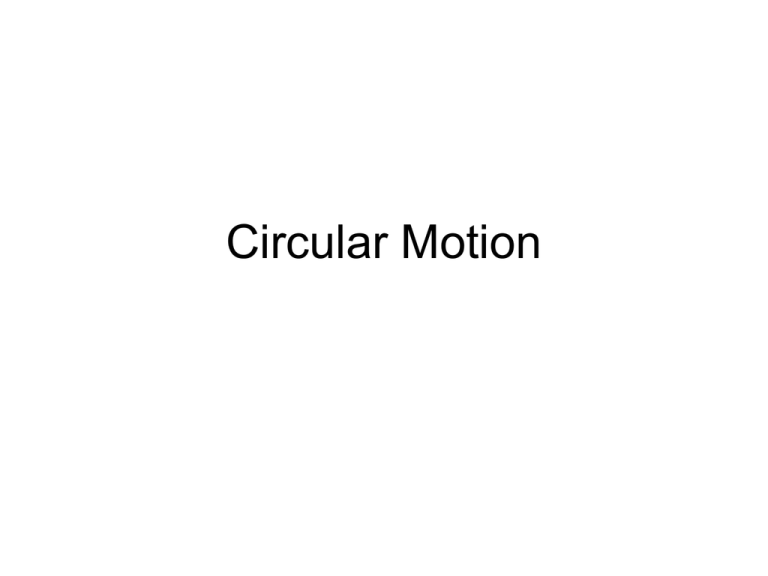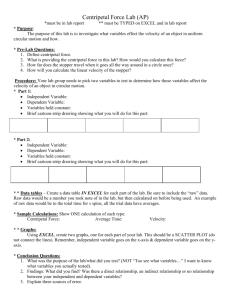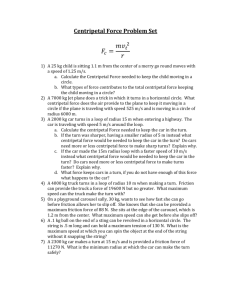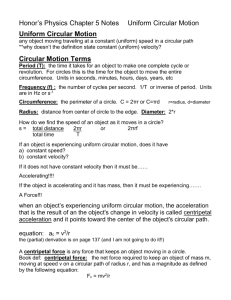Circular Motion: Physics Presentation
advertisement

Circular Motion Rotating Turning about an internal axis Revolving Turning about an external axis Linear speed, v How far you go in a certain amount of time Miles per hour, meters per second Rotational speed, w How many times you go around in a certain amount of time Revolutions per minute, rotations per hour, radians per second w = v/r (r = radius) Which horse has a larger linear speed on a merry go round, one on the outside or one on the inside? Outside. Which horse has a greater rotational speed? Neither, all the horses complete the circle in the same amount of time. How much faster will a horse at TWICE the distance from the center of the circle be moving Since both horses complete a circle in the same time, they have the same rotational speed, w. w = v/r v = wr TWICE the distance means TWICE the speed How do you find the velocity if it is not directly provided? Velocity = distance / time In circular motion, the distance traveled is all around the circle… the circumference. The circumference = 2pr So… v = 2pr / t The number of revolutions per second is called the frequency, f. Frequency is measured in Hertz, Hz. The time it takes to go all the way around once is called the period, T. Frequency is related to period by f=1/T Uniform Circular Motion, UCM: moving in a circle with a constant speed. Question: Is there a constant velocity when an object moves in a circle with a constant speed? No, the direction changes, therefore the velocity changes. If the velocity changed, the object is actually ACCELERATING even while moving at the same speed. Suppose an object was moving in a straight line with some velocity, v. According to Newton’s 1st Law of Motion, “An object in motion continues that motion unless a net external force acts on it”. If you want the object to move in a circle, some force must push or pull it towards the center of the circle. A force that pushes or pulls an object towards the center of a circle is called a centripetal force Centripetal means “center seeking” According to Newton’s 2nd Law, SF = ma, If there is a centripetal force, there must be a centripetal acceleration. ac = v2 / r Where r is the radius of the circle and v is the velocity of the object. Centripetal force Since SF= ma, the net centripetal force is given by 2 v SF m r Lots of forces can help in pushing or pulling an object towards the center of a circle. Sometimes it takes more than one force to get an object to move in uniform circular motion. Centripetal force is NOT a new kind of force. If any force is making an object move in a circle, it becomes a centripetal force. When can these forces be centripetal forces? Gravity? Moon revolving around the Earth Tension? Twirling a pail at the end of a string Friction? Cars rounding a curve. Air Resistance? Birds flying in a circle. Normal? Riders in a carnival ride Example A boy twirls a ½ kg rock in a horizontal circle on the end of a 1.6 meter long string. If the velocity of the rock was 4 m/s, what is the Tension in the string? m = ½ kg r = 1.6 m 2 v = 4 m/s The only centripetal force is Tension. T = m v2 / r T = ½ 42 / 1.6 T=5N v SF m r Example How fast was the ½ kg rock moving if the Tension was 10 N and the string was 1.6 m long? m = ½ kg r = 1.6 m T = 10 N T = mv2 / r Tr/m = v2 10 x 1.6 / .5 = v2 v = 5.7 m/s Only a component of the tension acts as a centripetal force! SF = mv2/r Tsinq = mv2/r and… Tcosq = mg Friction A 1500 kg race car goes around a curve at 45 m/s. If the radius of the curve is 100 m, how much friction is require to keep the car on the track? What is m, the coefficient of friction? m = 1500 kg v = 45 m/s r = 100 m The centripetal force is friction. v2 SF m r 2 f = mv /r f = 1500 x 452 / 100 f = 30375 N f = mN m= f / N N = mg = 15000 N m = 30375 N / 15000 N m = 2.02 The Normal force In some cases the normal force can contribute to the net centripetal force. For example, on the carnival ride where the riders stand against the walls of the circular room and the floor drops out! And yet, the rider does not slide down! Draw the free-body diagram! What keeps them from sliding down? The wall pushes against the rider toward the center of the circle. SFcentripetal v2 m r f N N = m v2 / r mg Banked Race Tracks- no friction! q q N mg The acceleration is NOT up or down the plane, but pointing toward the center of the track. We need to look for HORIZONTAL forces. Without friction, the ONLY force that points to the center of the track is the horizontal component of the Normal force. S F = Nsin q = mv2/r You will have to look at the vertical forces to determine the magnitude of the Normal force. Vertical loops Twirling a rock at the end of a string in a vertical loop. At the top of the loop, both the Tension and the weight point towards the center of the circle! SF = T + mg = mv2/r At the bottom of the loop, the Tension points toward the center, the weight away from the center: SF = T – mg = mv2/r What about an object on a vertical track? At the top of the track, both the Normal force and the weight point toward the center of the circle: SF = N + mg = mv2/r At the bottom of the track, the Normal force points toward the center and the weight points away from the center: SF = N – mg = mv2/r Air resistance (lift force) At the bottom of the loop: SF = Flift – mg = mv2/r Of course, the air lift force is not acting on the pilot! For the pilot, the two forces are his weight and the Normal force from the seat. N SF = mv2/r N – mg = mv2/r What about at the top of the loop? N Loop the Loop What is the minimum speed that a rider must be moving at in order to complete a loop the loop of radius 12 m? At the top of the loop, both the Normal force and weight point towards the center of the circle, so SFcentripetal = N + mg = mv2 / r However, at the minimum required speed, contact is lost for a moment at the top of the loop, so that… The Normal force goes all the way to ZERO. The weight is the only centripetal force when the rider is moving at the minimum required speed. v2 SF m r 2 mg = mv /r g = v2/r v2 = rg v2 = 12 x 10 v = 10.95 m/s Rounding the top of a hill Which force is pointing TOWARD the center? Which force is pointing AWAY from the center? SF = mv2/r mg – N = mv2/r If you are going fast enough to come up out of your seat, the Normal force pushing on you is… ZERO In that case… mg = mv2/r “Artificial Gravity” Occupants of a space station feel weightless because they lack a support (Normal) force. By spinning the station as just the right speed, they will experience a “simulated gravity” when the Normal force of the floor pushing on them becomes a centripetal force. The closer their centripetal acceleration, v2/r is to g, the acceleration due to Earth’s gravity, the more they feel the sensation of normal weight. Only a component of the lift force provides any kind of centripetal force! Tarzan plans to cross a gorge by swinging in an arc from a hanging vine . If his arms are capable of exerting a force of 1400 N on the rope, what is the maximum speed he can tolerate at the lowest point of his weight? His mass is 80 kg and the vine is 4.8 m long. SF = m v2/r T – mg = m v2/r V2 = (T – mg) r/m



